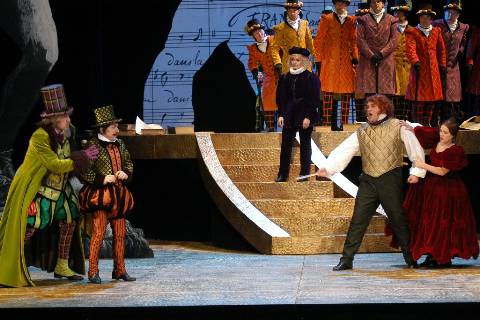|
<< -- 2 -- Robert Hugill CAPABLE AND ENTERTAINING

Doucet and Barbe's ultimate solution was to recognise that the role of Cellini has much in common with Berlioz's own struggles as an artist; so Cellini becomes Berlioz with Paul Charles Clarke dressed very much like the composer. The remaining costumes span the time difference, some Renaissance costumes and some from Berlioz's own time. Barbe's highly imaginative set designs utilise the theatricality of Berlioz's own life by mixing elements of theatrical décor (gilt prosceniums and boxes), blown up elements of 19th century pictures and images of Cellini's statue of Perseus, the casting of which forms the finale of the opera. From what I could see, the sets were also highly ingenious in the way they re-used various elements of the décor in different circumstances.
So far so good; but Barbe and Doucet introduce other elements. During the overture Cellini (Paul Charles Clarke) appears dragging a pile of manuscript paper attached via a chain to his ankle. He knocks on a series of doors, each is unanswered but the last one and from here he is thrown out quickly. Then a Harlequin figure appears (complete with a red wig matching Berlioz's own hair). Harlequin presents Berlioz with a copy of Benvenuto Cellini and suggests Berlioz himself playing the title role. Harlequin summons a group of other characters to help him. These Commedia dell'Arte characters are destined to play a significant role in the opera. Each is a shadow of a particular character so that besides Harlequin we have figures dressed like Teresa, Fieramosca and Balducci. At key moments, it is Harlequin and his cohorts who provide inspiration for Cellini rather than the artist himself. There are puzzling moments, such as Ascanio's Act 2 solo which is delivered to the Commedia dell'Arte characters (almost as if the director was reluctant to leave Ascanio (played wonderfully by Isabelle Cals) on stage too long.

A scene from the Opéra national du Rhin production of 'Benvenuto Cellini'. Photo © 2006 Alain Kaiser
|
The result was to minimise the artist's struggle that is implicit in the opera; part of the charm (or problem, depending on your point of view) of the work is the way Berlioz mixes sheer comedy with a depiction of the struggles of the artists. Doucet and Barbe played up the comedy in other ways as well. Fieramosca (Philippe Duminy) and Balducci (Fernand Bernadi) were costumed in rather caricatured versions of Renaissance costumes. Both had a good eye for comedy and played up the roles for all they were worth, making them rather too stereotypical for my taste. Duminy's first entrance in Act 1, for example, has him hiding behind a giant, moveable vase of flowers. Funny and amusing and very well staged, but this plays down any serious elements the scene might contain. Duminy is a genuinely funny person so his scenes were uniformly funny, which itself rather subverts the plot.
Continue >>
Copyright © 2 February 2006
Robert Hugill, London UK

|

